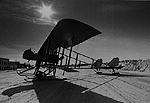Canada's first successful heavier-than-air flying machine is the Silver
Dart.
The story of the Silver Dart began in 1907, when the world-famous inventor
of the telephone, Dr. Alexander Graham Bell, and four promising young men
interested in aviation formed the Aerial Experiment Association (A.E.A).
Bell had previously performed aerodynamic experiments with kites, but he
was already in his 60th year, past the age for experimenting aboard untested
and frail flying machines.
The younger members of the A.E.A included Glenn Curtiss, an American designer
of internal combustion engines; Lieutenant Thomas Selfridge of the U.S.
Army; and two Canadians, John A.D. McCurdy and Frederick W. "Casey"
Baldwin, both recent engineering graduates from the University of Toronto.
The A.E.A.'s purpose was an ambitious one - no less than the construction
of a "practical aerodrome or flying machine driven through the air
by its own power and carrying a man." The Association operated alternately
out of Hammondsport, New York, where Curtiss had a machine shop, and Bell's
estate at Baddeck, a tiny Maritime village on Cape Breton Island, Nova
Scotia.
The A.E.A. was extremely successful, building and flying four airplanes
in rapid succession. The last of these was the Silver Dart, designed by
John McCurdy and considered one of the more advanced airplanes of its day.
On February 23, 1909, McCurdy made the first airplane flight in Canada
in the Silver Dart, taking off from the ice of Baddeck Bay and flying for
about 800 metres.
After 46 successful flights in the Silver Dart, some covering a distance
as great as 32 km, McCurdy and Baldwin attempted to raise funds for further
experiments by demonstrating the airplane before military authorities at
Camp Petawawa, Ontario, on August 2,1909. Unfortunately, on the landing
of the fourth flight of the day, the Silver Dart flipped over and was smashed
beyond repair.
That same year Louis Blériot made the first airplane flight across
the English Channel and, in France, the first international aviation meet
took place.
The French flyer who set the distance record at that first meet was Maurice
Farman, the designer of the "Shorthorn."
Many Canadians learned to fly in "Shorthorns," the basic trainers
of their day. The name came from the wooden skids that stick out in front
of the wheels. They stopped the aircraft from nosing over on landing --
there were no brakes in those days.

Maurice Farman S. 11 Shorthorn
© National Aviation Museum (Canada)
The network of control and bracing wires gave the aircraft the nickname
"cage à poules" or "chicken coop." People who
have experience with the aircraft said that, to check the rigging, you
put a sparrow between the wings -- if it flew out a wire was missing. With
their controls exposed to natural hazards and later enemy weapons, these
aircraft were very vulnerable.
Many other Canadians tried their hand at building and flying airplanes
before World War I. But the museum's only original airplane from Canadian
aviation's pioneer period - in fact, the only surviving Canadian aircraft
from this period anywhere, is the McDowall
Monoplane. Built by Robert McDowall, a municipal engineer from
Owen Sound in Ontario, it completed a few "hops," but never flew
successfully. Nevertheless, it remains a fascinating example of the efforts
of early aviation enthusiasts.
Looking at these early birds made of wood, wire and cloth, even the
propellers are wood, it is hard to believe that only 60 years later we
would land on the moon.
After the crash at Petawawa, McCurdy, Baldwin, and even Bell himself made
repeated appeals to the government in Ottawa for financial support for
aviation. But to no avail. Canada went into World War I without an air
service, and our main contributions were the provision of men and the manufacture
of training aircraft.